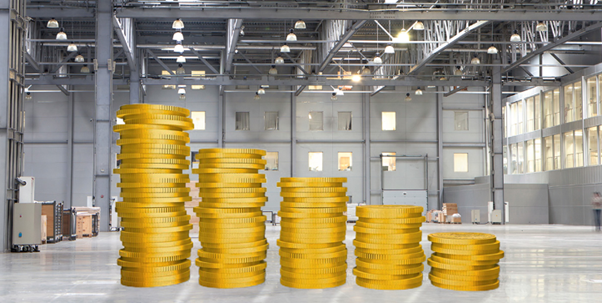
In a climate of rising costs, it’s important to uncover the solutions that will save you both time and money. That brings us to the question: How can I combat rising costs and positively impact my TCO (total cost of operation)? The answer is to improve the efficiency of your material handling operations.
Of course, no two operations are the same, so the layout and requirements of each building will differ. However, making incremental changes to your working environment can greatly improve your efficiencies, working to combat rising costs and positively impact your TCO.
When you work in a busy environment, being aware of any potential changes, or even considering how you could rework your operations, can be difficult if not impossible.
To get to grips with this concept a little better, ask yourself questions such as:
- Am I using the right equipment?
- Do I need to invest in new material handling equipment?
- Could I benefit from additional storage?
- Is my warehouse experiencing product damage?
- Am I struggling to hit my KPIs?
- Is my workforce at capacity?
- Are my operators happy and comfortable?
- Is there excessive truck downtime?
These questions will help you to better understand your situation and your challenges and will offer clarity into your material handling operations. Even if you believe you’re running a tight ship, revisiting questions like these will ensure that you are. Once you answer these questions, you can begin to take a deeper dive into your processes and better identify areas of improvement.
In this article, we will cover some of the best ways to reduce the costs of your operations. Read on to find out more.
How to combat rising costs and positively impact your TCO
When you think of streamlining your operational processes, chances are that you will envisage huge changes or your mind will jump to the prospect of having to make significant alterations, which can be quite overwhelming. However, you don’t need to reinvent the wheel to make improvements. Focusing on day-to-day activities can contribute to the overall profitability of your organisation.
1. Optimise your space
One way to positively impact your TCO and improve efficiencies is via storage optimisation. Ask yourself these questions:
- Are you maximising your storage capacity?
- Do you have external storage?
- Do you find yourself with pallets scattered around the floor struggling to know where to put the next pallet?
- Are you struggling to move things in and out of the building?
- Are you seeing damage to any equipment or products?
Struggling with storage or floor space means your operations will not be running as smoothly as they could be. This might incur situations where a job requires a team of operatives rather than a pair, for example, or additional machine usage, which means utilising additional resources or manpower to complete a task.
Extra steps taken in your day to day operations increase your cost of labour, and this could be happening due to an unorganised warehouse or a lack of storage. If you can reduce the number of movements that occur, you can save time and money. This doesn’t mean to say that fewer day-to-day actions will save time and, therefore, make people redundant – quite the opposite.
If you are able to properly manage your space and reduce the amount of movement around your warehouse, your operators will have more time to carry out different jobs and additional operations, which helps to positively impact your TCO.
Often, businesses are under pressure to be as productive as possible, which can be interpreted as maximising movement. Go deeper into the jobs you’re doing and try to optimise them. Consider how you’re managing your storage and workspace and assess whether or not this can be streamlined.
Related read: That’s the way we’ve always done it
2. The right equipment
The right equipment for the operation. When was the last time you reviewed the suitability of your equipment with regard to your operations? Applying the right pieces of equipment in your operations can greatly impact your TCO.
Ensure you’re aware of how your staff operate by looking at common issues such as double handling which can decrease efficiency. Consider this: you may have an order picking operation where a reach truck lifts pallets from higher levels; the pallet is then picked from before being placed back on the rack. It’s likely that this system requires multiple operatives.
To save time and increase productivity, you could use a high-level order picker which enables the operator to reach higher pallets without the additional aid of a reach truck. Ask yourself which vehicles are currently in operation, and which is the most relevant or applicable piece of equipment for the jobs at hand. This can be quantified by using simulation software.
To learn more about simulation software, take a look at this article: Planning a warehouse, or thinking of making changes: How to use simulation software to help
In these difficult times, it’s important to take a step back and look at your material handling and the equipment you’re using. In the overall cost of an operation, your equipment can be seen as a relatively small expense, however, the impact of having the right solution can have a much larger impact on your total cost of operation.
3. Power requirements
This ties in with our previous point of using the right equipment for the operation as energy is all-encompassing for TCO. To discover the right material handling solutions for you, you need to take a look at the battery change systems you use, and what your power requirements are.
In the world of material handling, there is a range of battery types you can choose from that span further than just lithium-ion or lead-acid batteries. Whilst each of these battery types has its benefits, to get to grips with your power requirements, you may have to look further than the prevalent battery types.
Different products from different manufacturers provide different advantages. It’s common for people in the material handling industry to say things like please don’t talk to us about battery changing. And that’s usually because something doesn’t work properly or they think an issue will require an awkward fix. Ultimately, if you don’t investigate the issue, your TCO will be impacted.
Related read: Forklift battery changeover: can you avoid this time-consuming process completely?
Investigating your power requirements can take many forms. You may need to invest in spare batteries or explore different battery technology. You could combat rising costs by investing in a solution that provides extended operating times or rapid charging, for example, negating the requirement to have spare batteries and battery changes.
Ultimately, when looking further into the inefficiencies around power requirements, considering the long-term costs over short-term fixes is key because minor, inexpensive adjustments can prevent damage, reduce downtime, and positively impact your overall TCO.
4. Your employees
Your employees are your greatest asset. Looking after people using your forklift trucks is just as important as investing in new equipment, power solutions, or storage management when it comes to combating rising costs.
To take care of your employees, you need to ensure they’re happy, comfortable, and safe. This is easily achieved by investing in driver-centric equipment that specifically offers a range of ergonomic features to assist with prolonged periods of operation.
Related read: Order picking and the human body: How to reduce injuries and strain
Being known as a material handling brand that values employee happiness and works to specifically cater for their safety and comfort will positively impact your brand image, reduce downtime, and increase your employee retention. This will, in time, reduce your long-term costs.
5. Site auditing
Taking a consultative approach to your material handling is one of the easiest ways to begin to streamline your operations. From taking a deep dive into your storage optimisation and finding the right equipment to understanding your power requirements and employee wellness, examining your processes via regular auditing will enable you to look at your operations with clarity and devise the best solutions to positively impact your TCO.
With each potential problem area, there could be a hybrid of different solutions that offer different advantages or disadvantages. Accessing a consultation from a reputable brand will help to clarify your needs, and requirements, and help you to find out the real route of your rising costs.
Related read: How to reduce costs in your operation when times are tough
UniCarriers bespoke consultation
TCO is multifaceted. Here at UniCarriers, we understand that no two operations are alike. To maximise your operational efficiency, we need to understand what you’re doing, so we can tailor our solutions to meet your requirements.
How do we do this? UniCarriers uses a Logistics Analyser to simulate any operations of any size and then compare and contrast solutions and determine the best outcome to optimise efficiency. This enables us to offer you a detailed analysis that’s based on real data.
UniCarriers offers a wide range of products and services fit for every operation. Whether it’s buying equipment, hiring for the long or short-term, or if you simply need service or spare parts, speak to one of our experts today to find out which is the best solution for you.
If you want to start working on reducing these costs, rather than focusing on the relatively small purchase price, you need to look at the whole picture. Download our free guide 'The total cost of owning a truck, and what affects it'.






































Comment